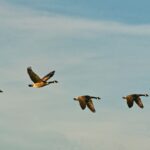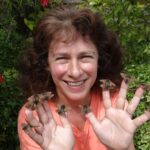Frontiers Award goes to biologist who demonstrated the impact of climate change on species displacement
The BBVA Foundation Frontiers of Knowledge Award in Climate Change and Environmental Sciences goes to US scientist Camille Parmesan for her pioneering studies showing that “wild species shift their geographical ranges in response to climate change,” moving toward the poles and higher elevations. This groundbreaking discovery laid “the foundations of climate change ecology,” according to the committee.

In the mid 1990s, Parmesan showed that several butterfly species in the United States and Europe were moving northwards and upward to escape rising temperatures. Over the next three decades, she expanded on this work to show that the same climate change impact was being felt by thousands of plant and animal species worldwide both on land and in the oceans.
Professor Parmesan was thus able to establish that rising temperatures had left a “globally coherent fingerprint” on biodiversity. An insight, said the committee, that “underpins climate change ecology,” one of the research fields most strongly to the fore in combating the environmental crisis.
Her research has provided vital input to the design of effective conservation strategies “adopted by governments and agencies around the world” that factor species displacements due to global warming; among them, the creation of corridors to connect habitats, assisted migrations and protected areas that provide a refuge for wildlife affected by rising temperatures.
Impact on health, fisheries, and agriculture
Parmesan’s work has “major ramifications for global public health, due to the polewards expansion of tropical diseases like malaria or dengue that are transmitted by mosquitos, as well as for sectors such as agriculture and fisheries, which will need to come to terms with the warming-driven migrations of terrestrial and marine species,” explains committee secretary Carlos Duarte, holder of the Tarek Ahmed Juffali Research Chair in Red Sea Ecology at King Abdullah University of Science and Technology (Saudi Arabia).
Parmesan explains that, “Where you can grow things is shifting, and farmers have already realized this. And fishermen are noticing that the species they catch are not the same as before. Not only that, diseases too are moving polewards. There are even pathogens that are remerging as the Arctic ice melts. For instance, cases of anthrax have been found among the reindeer that form part of the diet of Inuit populations. The animals, it turns out, contracted the disease when the bacteria that causes it was released into the atmosphere as the tundra thawed. Then you have the fact that higher atmospheric CO₂ is lowering the nutritional value of crops, which is something that’s starting to worry dietitians.”

Camille Parmesan
The emergence of climate change ecology
Camille Parmesan began her research career studying plant-insect interactions. She was nearing the end of her PhD course when she responded to a NASA grant call with an “extremely risky” proposal to study the impact of climate change on Edith’s checkerpoint butterfly (Euphydryas editha), known to be sensitive to climate variability. At that time, in the early 1990s, scientists were already expecting that increased atmospheric CO2 would drive up temperatures globally, although the warming trend was yet to make itself felt. But Parmesan’s years of experience with the checkerspot got her thinking: “Maybe this little butterfly is a better indicator than any thermometer.”
“I think that was a truly innovative leap in ecology research,” she recalls today, reflecting on her decision to opt for analysis of observational data over the experimental approaches then in vogue. “The question of whether a change in climate has globally affected a wild species is not something you can address using experiments. I knew it was not enough just to show a change. I needed to be able to say this change is definitively linked to climate change and not all the other things that humans are doing.” The sheer breadth of her data and the inductive reasoning she used to rule out all other effects and attribute the extinction patterns of Edith’s checkerspot butterfly exclusively to climate change were precisely the factors that convinced the research community that the impact of rising temperatures on wild species was real, and, in the process, brought into being the new field of climate change ecology.
The “globally coherent fingerprint” of temperature increase
She then set out to test the effect on other butterfly species, this time in Europe. Ignoring the criticism from certain researchers whose study environments were too small for them to observe the patterns Parmesan was seeing, she traveled from Spain to Finland collecting data as she went that pointed firmly to just one conclusion: that two-thirds of the species studied were moving northward. As an early participant in the work of the U.N.’s Intergovernmental Panel on Climate Change (IPCC), her next step was to scale up these attribution studies to thousands of animal species both on land and in the oceans.

Camille Parmesan
The researcher has lately returned her attention to Edith’s checkerspot butterfly in light of signs that it may be evolving in real time in response to climate change. “This is not necessarily a good thing,” she points out, “because it’s evolving to deal with soil that’s getting too hot by laying its eggs further north and higher up, but that’s making it susceptible to other pressures.”
In fact, the last few years have witnessed the first extinctions linked directly to climate change, like that of the rodent Melomys rubicola or the golden toad (Incilius periglenes). “It’s all ramping up,” says a concerned Parmesan. “And we’re seeing changes at a pace that really I would not have predicted 10 or 20 years ago.”
Lessons for biodiversity, agriculture and fisheries
After publishing her paper on attribution methodology, Parmesan decided it was time to take the message to conservation biology forums: “Climate change is above and beyond all of those local things, like invasive species or habitat destruction. And if you ignore it, you will drive everything extinct in areas where you’re trying to protect them.”
In consonance with this view, she contends that conservation strategies should not target a particular species but rather biodiversity in general. There will be species, like the polar bear, who are undoubtedly heading for extinction, so isn’t it better, she argues, to have it hybridize with other species, like the grizzly, rather than try to preserve it in its pure form. “By going ahead and letting these hybridizations happen, you’re keeping those genes in the pool, so if we ever stabilize climate and start cooling it down again, then you’ve got genes around that can then re-evolve some of these cold-adaptive species. If we do the opposite and stop them from happening, we are going to lose a lot of genetic diversity.”